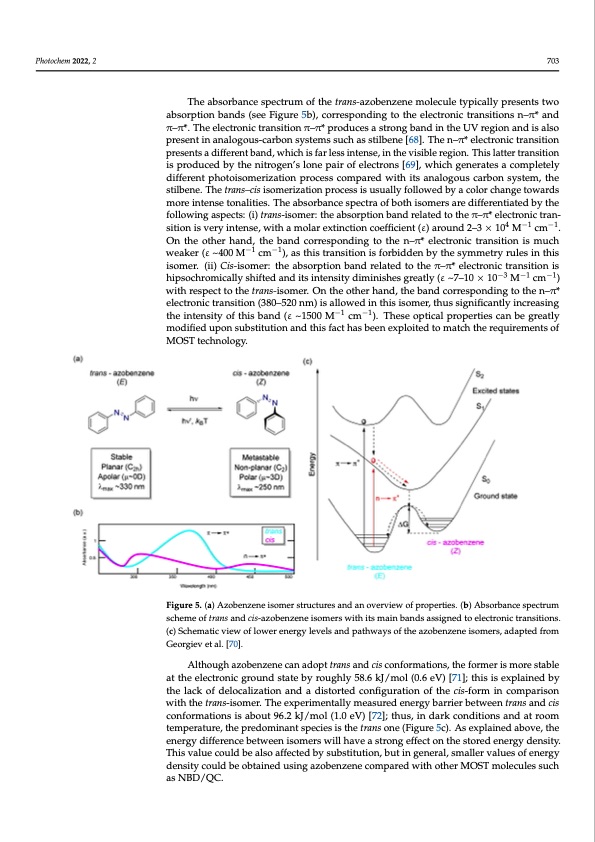
PDF Publication Title:
Text from PDF Page: 010
Photochem 2022, 2 703 The absorbance spectrum of the trans-azobenzene molecule typically presents two absorption bands (see Figure 5b), corresponding to the electronic transitions n–π* and π–π*. The electronic transition π–π* produces a strong band in the UV region and is also present in analogous-carbon systems such as stilbene [68]. The n–π* electronic transition presents a different band, which is far less intense, in the visible region. This latter transition is produced by the nitrogen’s lone pair of electrons [69], which generates a completely different photoisomerization process compared with its analogous carbon system, the stilbene. The trans–cis isomerization process is usually followed by a color change towards more intense tonalities. The absorbance spectra of both isomers are differentiated by the following aspects: (i) trans-isomer: the absorption band related to the π–π* electronic tran- sition is very intense, with a molar extinction coefficient (ε) around 2–3 × 104 M−1 cm−1. On the other hand, the band corresponding to the n–π* electronic transition is much weaker (ε ~400 M−1 cm−1), as this transition is forbidden by the symmetry rules in this isomer. (ii) Cis-isomer: the absorption band related to the π–π* electronic transition is hipsochromically shifted and its intensity diminishes greatly (ε ~7–10 × 10−3 M−1 cm−1) with respect to the trans-isomer. On the other hand, the band corresponding to the n–π* electronic transition (380–520 nm) is allowed in this isomer, thus significantly increasing the intensity of this band (ε ~1500 M−1 cm−1). These optical properties can be greatly modified upon substitution and this fact has been exploited to match the requirements of MOST technology. Figure 5. (a) Azobenzene isomer structures and an overview of properties. (b) Absorbance spectrum scheme of trans and cis-azobenzene isomers with its main bands assigned to electronic transitions. (c) Schematic view of lower energy levels and pathways of the azobenzene isomers, adapted from Georgiev et al. [70]. Although azobenzene can adopt trans and cis conformations, the former is more stable at the electronic ground state by roughly 58.6 kJ/mol (0.6 eV) [71]; this is explained by the lack of delocalization and a distorted configuration of the cis-form in comparison with the trans-isomer. The experimentally measured energy barrier between trans and cis conformations is about 96.2 kJ/mol (1.0 eV) [72]; thus, in dark conditions and at room temperature, the predominant species is the trans one (Figure 5c). As explained above, the energy difference between isomers will have a strong effect on the stored energy density. This value could be also affected by substitution, but in general, smaller values of energy density could be obtained using azobenzene compared with other MOST molecules such as NBD/QC.PDF Image | Overview of Molecular Solar Thermal Energy Storage

PDF Search Title:
Overview of Molecular Solar Thermal Energy StorageOriginal File Name Searched:
photochem-02-00045-v2.pdfDIY PDF Search: Google It | Yahoo | Bing
Turbine and System Plans CAD CAM: Special for this month, any plans are $10,000 for complete Cad/Cam blueprints. License is for one build. Try before you buy a production license. More Info
Waste Heat Power Technology: Organic Rankine Cycle uses waste heat to make electricity, shaft horsepower and cooling. More Info
All Turbine and System Products: Infinity Turbine ORD systems, turbine generator sets, build plans and more to use your waste heat from 30C to 100C. More Info
CO2 Phase Change Demonstrator: CO2 goes supercritical at 30 C. This is a experimental platform which you can use to demonstrate phase change with low heat. Includes integration area for small CO2 turbine, static generator, and more. This can also be used for a GTL Gas to Liquids experimental platform. More Info
Introducing the Infinity Turbine Products Infinity Turbine develops and builds systems for making power from waste heat. It also is working on innovative strategies for storing, making, and deploying energy. More Info
Need Strategy? Use our Consulting and analyst services Infinity Turbine LLC is pleased to announce its consulting and analyst services. We have worked in the renewable energy industry as a researcher, developing sales and markets, along with may inventions and innovations. More Info
Made in USA with Global Energy Millennial Web Engine These pages were made with the Global Energy Web PDF Engine using Filemaker (Claris) software.
Sand Battery Sand and Paraffin for TES Thermo Energy Storage More Info
| CONTACT TEL: 608-238-6001 Email: greg@infinityturbine.com | RSS | AMP |